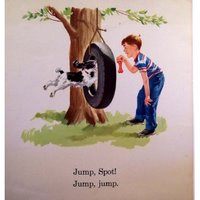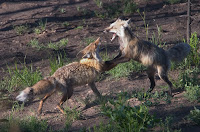(Here's some really long musings for Earth Day)
Back around 1998 or so I met weekly with some friends at Lori's Coffeehouse for what we finally came to call the Cultural Inventors Collective. Believe me, these were people who loved ideas and there were several get-togethers discussing why we felt the need to assign ourselves a name. That's a different story.
On a slightly balmy spring evening, we moved outside once Lori's closed. As we sat back on the grass looking up at the moon, I thought back to when I was a child looking up at the stars. As I stared at that same moon that had gotten me though so many nights I began to think about the nature of meaning. The topic was near to heart as one of my friends who was present was grappling with the issue of meaning in her own life. She was having a crisis of meaning.
Her spiritual path was Buddhism and her educational path was Cultural Studies. She told me that Buddhism teaches that meaning inherently exists and because she believed her teachings, it was so. Likewise, Cultural Studies teaches that meaning is not inherent but rather is a product of (or is created by) discourse and because she believed her teachings, it was so.
One of my favorite Zen sayings is:
If we understand,
things are just as they are
If we do not understand,
things are just as they are.
I guess we could have left it at that but we didn't. I felt the need to show that these two ideas are really the same. Discourse does create meaning but it can do so in a way that fundamentally springs forth from the inherent properties that exist in the world. That meaning is there whether a human bothers to ponder it or not.
Meaning According to Cultural Studies
The premise of meaning as defined by cultural studies academics is that discourse about existing texts, or discourse which creates new texts (though the two are not necessarily mutually exclusive) create meaning. This is a very general description. To be clearer, discourse creates meaning and a text is the record of that created and possibly shared meaning.
As my friend tried to explain the above to me and as we discussed the nature of meaning it became clear that this was at the very root of her spiritual crisis. The idea of meaning being created exclusively through discourse seemed to contradict her spiritual teachings with regard to the inherent nature of meaning in the universe. The Cultural Studies definition clearly states that meaning is not an inherent property in the universe but rather created and that the specific creative process is discourse.
I’ve gone to the trouble to lay out the cultural studies model because it so closely follows the cultural views of one particular culture, that being our scientifically driven “western” culture. We have an anthropocentric view of the nature of meaning. i.e. meaning is constructed and that construction is by humans. The idea is that we create meaning in the world though our language and since only we use language, we create and are in charge of all the meaning in the world.
Pushing Boundaries
Q. Is meaning created or inherent?
The answer is clear.
A. Yes.
How can it be both? Yes as an answer makes sense from an eco-centric rather than human-centric perspective.
In order to understand the dual nature of meaning we must examine the concept of text. Text is the link between discourse and meaning. It is the result of discourse and it is from texts that meaning is divined (according to cultural studies). Cultural studies views texts in the literal sense of a written document but also words that could be written down in such a form. I submit that discourse can be nonverbal, and can occur without conscious intent to do so.
I’ve now strayed beyond where the traditionalist Cultural Studies students will usually tread but I think most are still along for the ride. My friend begrudgingly came at least this far. It seems logical, though a bit unorthodox, to assume that a nonverbal discourse creates both text and meaning. If this were not the case the game of charades would be utterly unimaginable and mimes would be even less comprehensible than they already are.
This next leap of logic will lose all of the traditionalists who may have indulged in idle curiosity up until this point.
Discourse, both conscious and non-conscious can occur between two or more humans, between humans and non-human animals, between animals (humans included) and "inanimate" objects, and even (take a deep breath) between two inanimate objects. (Though according to my own definition there really is no such thing as an inanimate object since everything constantly interacts, albeit sometimes subtly, with everything else and as such is animate.)
In this context, let us say that an animate world is one in which all things partake in discourse. This discourse creates readable texts and these texts, since they are derived from discourse, form the basis of meaning.
When I walk outside, the world is full of meaning. To say the meaning is inherent is perhaps shy of the target. I am not sure the meaning is so much inherent, more that meaning inherently exists in a general sense since the discourse never stops. See the subtle difference? In the end, the difference may be of little consequence.
When two humans come to a conversation they bring with them the makings of discourse that can, in a general sense, be called properties. It is the interaction of these properties that craft the nature of the text that is created through discourse between the two humans. If we change the properties of the humans then the resulting text is changed. For example, if we change say one person's religion, i.e. beliefs, i.e. properties, then we may see a change in the text as the discourse will be different.
Ah, but physical properties change the discourse and resulting text as well. If I change the sex of one of the people then the discourse will most likely be changed and as a result, we have a different text.
Human to Human Verbal Discourse
Now, if I get into an intellectual fight with a person, I submit to you that this is a discourse and we will create a text as a result. To be very concrete about it let us say the text is an actual transcript of our words. This is the traditional model. Human to Human Non-Verbal Discourse
Human to Human Non-Verbal Discourse
Now, if I get into a physical fight with a person, I submit to you that this is a discourse and we will create a text as a result. To be very concrete about it let us say that the resulting "text" is a series of cuts on each other, scuffs on the dirt and maybe, just to be extravagant about it, some shed blood on the ground. This is truly a text as we can come by and “read" it and understand meaning, i.e. some sort of fight took place here. Sure, not mind blowing meaning but Dick and Jane books aren't mind blowing texts either.
Human to Animal Non-Verbal Discourse
Now, if I get into a physical fight with a rabid fox, I submit to you that this is a discourse just a surely as the above example and we will create a text as a result. To be very concrete about it let us say that the resulting "text" is a series of cuts on each other, scuffs on the dirt and maybe, just to be extravagant about it, some shed blood on the ground. The result is a text as surely as it is in the above example.
Animal to Animal Non-Verbal Discourse If you accept that a human fighting a human creates a text and that we can substitute a fox for one of the humans and still create a text then why not submit a fox for the other human as well? I submit that the same paragraph could read "if a fox got into a physical fight with a fox. . ." (photograph by Robert Weselmann)
If you accept that a human fighting a human creates a text and that we can substitute a fox for one of the humans and still create a text then why not submit a fox for the other human as well? I submit that the same paragraph could read "if a fox got into a physical fight with a fox. . ." (photograph by Robert Weselmann)
Here’s where we go into the realm of the supposedly “inanimate objects” We have thus far established that two animate objects, both bringing properties, can meet and have an interaction which we will call a discourse. It may be a non-verbal discourse but a discourse none the less. This discourse, like all discourses, will create a text, even if that text is a simple as a few marks on the ground. I ask you to consider the following. "Inanimate" to "Inanimate" Non-verbal Discourse
"Inanimate" to "Inanimate" Non-verbal Discourse
If wind, in the form of a tornado, has a "fight"or interaction with a landscape, I submit to you that there will be an interaction between the properties of the tornado and the properties of the land. This fits our definition of a discourse. Two physical entities come together, both bringing properties, they interact (discourse) and the result is a text. To be very concrete about it let us say that the resulting "text" is a huge path of destruction. The text on a grand scale simply reads, a tornado came through here.
When humans read this text, they can see the inherent meaning that exists because of that text but also create new meaning based upon it. The text may say this was a very strong tornado, to say that it was an"F5 rating" tornado is to ascribe human meaning and classification on top of existing meaning. The existing meaning was “inherently” there as it was created before we arrived through the natural workings of the dynamic earth.
You could say my argument is, if a tree falls in the woods and no humans are there to see it happen does it still mean something? Of course it does!
A World of Meanings and Texts
In my line of work as a naturalist, everything is a text. There is meaning already existing in those texts. Our discourse of those texts creates further meaning, for sure, but that does not negate the inherent nature of the meaning already there. I hear the meaning in the Phoebe's call, I hear the meaning in the warning call of the chickadee. I see the meaning in cumulonimbus clouds.
Q. Is meaning created or inherent?
The answer is clear.
A. Yes.
Friday, April 20, 2007
Ecological Discourse and the Nature of Meaning
Subscribe to:
Post Comments (Atom)




No comments:
Post a Comment